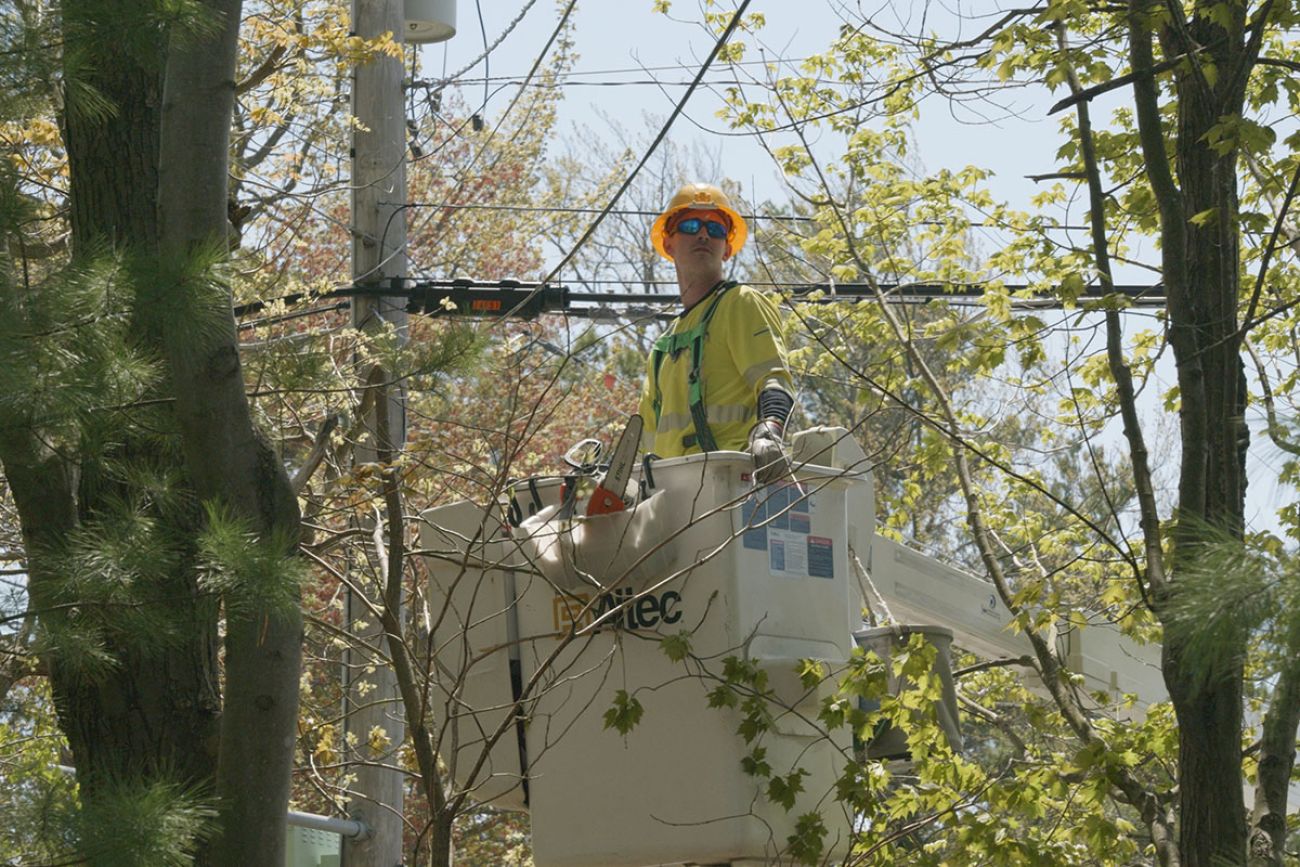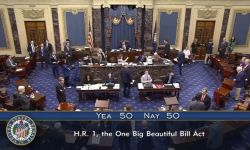Michigan utilities explore longer-term funding to address extreme weather

- Both DTE Energy and Consumers Energy have made maintenance improvements that the state says should improve reliability in 2024
- However, both continue to seek longer-term funding for major capital projects to further ‘harden’ the grid
- Michigan’s largest electric utilities face scrutiny over severe outages in 2023
Michigan’s two largest public utilities face ongoing questions about the reliability of their electrical grids amid more extreme weather linked to climate change.
DTE Energy and Consumers Energy are making maintenance changes to reduce power outages in 2024, but they are also looking beyond traditional tasks like tree-trimming to longer-term funding options for upgrading electricity transmission systems.
Doing so could put customers on the hook to repay today’s storm damage and prevention upgrades for years or even decades.
Related:
- DTE Energy cut operations to meet profits months before power outages
- In settlement with critics, DTE Energy agrees to faster coal phase-out
- DTE monthly rates to jump by 6.4% on Dec. 15 to fund clean energy
- Michigan regulators seek penalties for repeat utility outages
Both utilities spent millions more than budgeted this year restoring power after outages during major storms that were severe enough for the Michigan Public Service Commision (MPSC) to initiate an audit of both companies’ operations. Initial results are expected by Dec. 31.
DTE CEO Jerry Norcia said during an analyst call on Nov. 1 that the utility “has to consider” funding options such as those used by tornado-heavy and hurricane-prone southern states, like setting up a surcharge on customers’ bills to fund a severe weather escrow account.
The move, Norcia said, would take increasingly common extreme weather costs out of regular rate-planning. In Louisiana, which faces the steepest storm-related fixes in the U.S., such surcharges range from $15 to $45 per month.
“These volatile … storm environments start to whipsaw our maintenance plans and potentially even your capital deployment plans,” Norcia said.
Weather extremes also are prompting the MPSC, which regulates state utility rates, to consider an incentive system for utility companies to reach minimum reliability standards or face potential penalties. Michigan ranks 43rd in the U.S. for power grid reliability, according U.S. News & World Report.
Changes made by utility companies over the year and forecasts of a milder winter leave the state “better placed than we were last year” ahead of storm season, Dan Scripps, chair of the commission, told Bridge Michigan.
“But we're clearly not out of the woods,” Scripps said when it comes to the risk of major outages due to severe weather events increasing in intensity and duration. “It seems like we're getting every-50-years’ weather events essentially every other year at this point.”
DTE [NYSE: DTE] serves about 2.3 million customers in southeast Michigan, while Consumers [NYSE: CMS] serves 1.8 million in the Lower Peninsula.
Both companies faced heat from customers, municipal officials and the state as extended outages this year included a February ice storm that hit the upper Midwest, leaving 1.3 million Michigan customers of the two utilities without power, some for nearly a week.
Another extended outage struck the state following severe thunderstorms in August, resulting in flooding and power outages to at least 740,000 customers.
Ratepayers who fund the utilities, Scripps said, are “fed up” with outages. Many expressed their anger through the fall as the commission sought public comment on utility storm performance.
DTE and Consumers — along with the MPSC — are increasingly considering financial mechanisms that will stabilize funding for longer-term, more capital-intensive projects that “harden” the grid, such as underground power lines, as unusually severe weather becomes more common and has to be absorbed by operating budgets.
By the third quarter of 2023, DTE said last month, about $271 million in unanticipated storm spending pressured the utility’s budget, which also was $100 million under expected revenue after a MPSC rate decision in late 2022. The $22-billion utility reduced its earning-per-share outlook by 50 cents to $5.75 last month, while third-quarter earnings reached $332 million, down $55 million from the same period a year earlier.
Over five years, DTE said it plans to spend $13 billion in electricity distribution upgrades, expecting 60 percent better reliability.
At Consumers, the five-year cost of improvements to withstand stronger storms could reach $7 billion, CEO Garrick Rochow told analysts on a third-quarter call on utility earnings. That amount, $3 billion over its previous plan, should keep all of its customers from experiencing an outage longer than 24 hours, the utility said.
The catastrophic storms this year prompted the utilities to boost attention to steps like tree-trimming, which they said is the most effective way to keep exposed power lines from damage in a storm.
New utility line standards also are in place, since winds coming off the Great Lakes carry particular risk for Michigan, which is up to 50 percent windier than Wisconsin.
“Originally our design standard was for 40-mile per hour wind. With the wind speeds we are seeing today, our new standard is for 80-mile per hour wind and 0.5 inch of ice loading,” Rochow said.
Greg Salisbury, Consumers’ vice president of electric engineering, told Bridge last week the utility spent $108 million on tree-trimming in 2023, 8 percent more than budgeted. Trimming used to cycle through every 14 years, but the utility is more than halfway to reducing the cycle to seven years.
The utility also is “getting smarter” about line inspection, Salisbury said, thanks to satellite imagery and technology that directs crews to the highest-risk areas.
Consumers said its operating expenses reached $1.28 billion in the first three quarters of the year, up $145 million, about 11 percent higher. The utility’s electric rate increased 2 percent in January 2023.
DTE is trying to accelerate its response to downed wires, Joseph Musallam, DTE vice president of distribution operations, told Bridge in a statement. The utility also is turning to technology, including an algorithm to forecast outage volumes and sensors that help it to locate outages more quickly.
Yet storm restoration remains an annual variable, and money that must be immediately spent when outages occur.
DTE’s most recent rate request, approved in part by the MPSC in late November, raised electrical rates by 6.4 percent (about $6.51 on an average bill) and allows the electric provider to bill customers for specific capital improvements, said Scripps of the MPSC.
That will set a budget for DTE to invest in items like conversion to higher voltage and more reliable power lines without waiting for regulatory approval. The benefit to the utility and customers, Scripps said, is that the spending can only be made for reliability improvements.
Consumers Energy, in a pending rate case, also is seeking a multi-year capital plan to identify dedicated funding for larger-scale changes and maintain it over several years.
Beyond a storm escrow, another funding option that could be used by the utilities is securitization, or selling bonds to cover costs stemming from extreme storms. The move would allow a utility to raise funds for weather event repair without raising base rates, though customers cover the bond debt over several years. One benefit to consumers is the debt interest payment is lower than through typical borrowing, even as the issuer charges a fee, though the duration of the repayments could extend for generations.
For example, the Public Service Co. of Oklahoma was allowed to sell bonds to cover $675 million in damage from the state’s 2021 uncharacteristic winter freeze, an amount that reportedly could have cost ratepayers an extra $476 per month without the bond deal. Securitizing the debt allowed the payments to be about $4 per month for each customer, but for 20 years.
Scripp said bond sales have been used in Michigan, including by DTE, to fund some tree-trimming efforts before the pandemic.
“We haven't … had requests today to use it for recovery of storm-related costs,” Scripps said, “although it certainly is an option that's out there.”
The Citizens Utility Board of Michigan, which represents consumers in utility issues like MPSC rate cases, is wary of the search for more funding structures even if they carry the potential to boost reliability, said Amy Bandyk, executive director.
A storm contingency fund, for example “would be slapping another charge onto ratepayer bills” in a state that already has the highest residential rate in the Midwest, she told Bridge.
For example, DTE has already overlooked cost-effective solutions to improve the grid by choosing to replace equipment more often than may be necessary, she said. Attention needs to be spent instead on aligning the utility’s reliability and financial goals, she said.
CUB could support strategies like tracking storm related spending in a year that could be added to future rate increases for subsequent years, Bandyk said.
Meanwhile, Scripps said he’s hopeful the ongoing MPSC audit and potential incentive system could address bigger-picture issues with the utilities.
“Michigan customers expect that their system is going to keep pace with the changes in the weather that we're seeing and not get worse,” Scripps said.
The smaller changes, like tree-timing, are a good step, he said, “but we haven’t yet turned the corner in terms of system level performance.”
Business Watch
Covering the intersection of business and policy, and informing Michigan employers and workers on the long road back from coronavirus.
- About Business Watch
- Subscribe
- Share tips and questions with Bridge Business Editor Paula Gardner
Thanks to our Business Watch sponsors.
Support Bridge's nonprofit civic journalism. Donate today.
See what new members are saying about why they donated to Bridge Michigan:
- “In order for this information to be accurate and unbiased it must be underwritten by its readers, not by special interests.” - Larry S.
- “Not many other media sources report on the topics Bridge does.” - Susan B.
- “Your journalism is outstanding and rare these days.” - Mark S.
If you want to ensure the future of nonpartisan, nonprofit Michigan journalism, please become a member today. You, too, will be asked why you donated and maybe we'll feature your quote next time!




